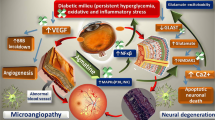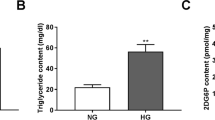Abstract
Blood–retinal barrier breakdown is the main pathological characteristics of diabetic retinopathy (DR). Asymmetric dimethylarginine (ADMA) was reported to be elevated in DR patients. In this study, we observed the dynamic profile of ADMA, retinal morphology and permeability of BRB at 2, 4 or 8 week of diabetic rats induced by a single intraperitoneal injection of streptozocin (60 mg/kg) and in cultured rat retinal pericytes pretreated with d-glucose (30 mM) for 1, 3, 5 and 7 days or ADMA (3, 10, 30 μM) for 24, 48 and 72 h, trying to explore the effects of ADMA on blood–retinal barrier in DR. Gap junction intercellular communication (GJIC) and the expression of blood–retinal barrier-specific component connexin 43 (Cx43) were examined in diabetic rats or cultured retinal pericytes to elucidate whether ADMA impacted blood–retinal barrier function via damaging Cx43-GJIC. The results showed that with increasing duration of diabetes, the ultrastructure of blood–retinal barrier of diabetic rats appeared cell junction damage, apoptosis of retinal pericytes and breakdown of barrier successively. The increases in retinal permeability, ADMA levels and Cx43 expression, and abnormal GJIC were observed in diabetic rats and retinal pericytes exposed to d-glucose (30 mM). A glucose-like effect was seen using ADMA or another l-arginine analogue NG-monomethyl-l-arginine or dimethylarginine dimethylaminohydrolases (DDAHs) siRNA, implicating that ADMA aggravated the breakdown of blood–retinal barrier via damaging Cx43-GJIC.





Similar content being viewed by others
Abbreviations
- DR:
-
Diabetic retinopathy
- ADMA:
-
Asymmetric dimethylarginine
- DDAH:
-
Dimethylarginine dimethylaminohydrolase
- L-NMMA:
-
NG-Monomethyl-l-arginine
- GJIC:
-
Gap junction intercellular communication
- RPCs:
-
Retinal pericytes
- BRB:
-
Blood–retinal barrier
- Cx43:
-
Connexin 43
- DM:
-
Diabetes mellitus
- STZ:
-
Streptozotocin
- EB:
-
Evans blue
- TER:
-
Transcellular electrical resistance
- HPLC:
-
High-performance liquid chromatography
References
Abhary S, Kasmeridis N, Burdon KP, Kuot A, Whiting MJ, Yew WP, Petrovsky N, Craig JE (2009) Diabetic retinopathy is associated with elevated serum asymmetric and symmetric dimethylarginines. Diabetes Care 32(11):2084–2086
Bobbie MW, Roy S, Trudeau K, Munger SJ, Simon AM, Roy S (2010) Reduced connexin 43 expression and its effect on the development of vascular lesions in retinas of diabetic mice. Invest Ophthalmol Vis Sci 51:3758–3763
Chen QQ, Li D, Guo R, Luo D, Yang J, Hu CP, Li YJ (2008) Decrease in the synthesis and release of calcitonin gene-related peptide in dorsal root ganglia of spontaneously hypertensive rat: role of nitric oxide synthase inhibitors. Eur J Pharmacol 596:132–137
Chen Y, Xu X, Sheng M, Zhang X, Gu Q, Zheng Z (2009) PRMT-1 and DDAHs-induced ADMA upregulation is involved in ROS- and RAS-mediated diabetic retinopathy. Exp Eye Res 89:1028–1034
Chen N, Leng YP, Xu WJ, Luo JD, Chen MS, Xiong Y (2011a) Contribution of endogenous inhibitor of nitric oxide synthase to hepatic mitochondrial dysfunction in streptozotocin-induced diabetic rats. Cell Physiol Biochem 27:341–352
Chen YH, Xu X, Sheng MJ, Zheng Z, Gu Q (2011b) Effects of asymmetric dimethylarginine on bovine retinal capillary endothelial cell proliferation, reactive oxygen species production, permeability, intercellular adhesion molecule-1, and occludin expression. Mol Vis 17:332–340
Dongare S, Gupta SK, Mathur R, Saxena R, Mathur S, Agarwal R, Nag TC, Srivastava S, Kumar P (2016) Zingiber officinale attenuates retinal microvascular changes in diabetic rats via anti-inflammatory and antiangiogenic mechanisms. Mol Vis 22:599–609
Du W, Yu W, Huang L, Zhao M, Li X (2012) Ephrin-A4 is involved in retinal neovascularization by regulating the VEGF signaling pathway. Invest Ophthalmol Vis Sci 53:1990–1998
Du MR, Yan L, Li NS, Wang YJ, Zhou T, Jiang JL (2018) Asymmetric dimethy-larginine contributes to retinal neovascularization of diabetic retinopathy through EphrinB2 pathway. Vasc Pharmacol 108:46–56
Guo YJ, Chen L, Bai YP, Li L, Sun J, Zhang GG, Yang TL, Xia J, Li YJ, Chen XP (2010) The ALDH2 Glu504Lys polymorphism is associated with coronary artery disease in Han Chinese: relation with endothelial ADMA levels. Atherosclerosis 211:545–550
Jacobi J, Maas R, Cardounel AJ, Arend M, Pope AJ, Cordasic N, Heusinger-Ribeiro J, Atzler D, Strobel J, Schwedhelm E, Boger RH, Hilgers KF (2010) Dimethylarginine dimethylaminhydrolase overexpression ameliorates atherosclerosis in apolipoprotein E-deficient mice by lowering asymmetric dimethylarginine. Am J Pathol 176:2559–2570
Jadeja S, Mort RL, Keighren M, Hart AW, Joynson R, Wells S, Potter PK, Jackson IJ (2013) A CNS-specific hypomorphic Pdgfr-beta mutant model of diabetic retinopathy. Invest Ophthalmol Vis Sci 54:3569–3578
Jia SJ, Zhou Z, Zhang BK, Hu ZW, Deng HW, Li YJ (2009) Asymmetric dimethylarginine damages connexin43-mediated endothelial gap junction intercellular communication. Biochem Cell Biol 87:867–874
Jiang JL, Li Ns NS, Li YJ, Deng HW (2002) Probucol preserves endothelial function by reduction of the endogenous nitric oxide synthase inhibitor level. Br J Pharmacol 135:1175–1182
Kim SJ, Kim S, Park J, Lee HK, Park KS, Yu HG, Kim Y (2006) Differential expression of vitreous proteins in proliferative diabetic retinopathy. Curr Eye Res 31:231–240
Krzyzanowska K, Mittermayer F, Schernthaner GH, Brunner S, Brix JM, Aschauer S, Höllerl F, Wolzt M, Schernthaner G (2011) Renal function but not asymmetric dimethylarginine is independently associated with retinopathy in type 2 diabetes. Cardiol Res Pract 2011:260191
Li AF, Roy S (2009) High glucose-induced downregulation of connexin 43 expression promotes apoptosis in microvascular endothelial cells. Invest Ophthalmol Vis Sci 50:1400–1407
Li AF, Sato T, Haimovici R, Okamoto T, Roy S (2003) High glucose alters connexin 43 expression and gap junction intercellular communication activity in retinal pericytes. Invest Ophthalmol Vis Sci 44:5376–5382
Liu J, Li C, Chen W, He K, Ma H, Ma B, Zhao P, Tian L (2019) Relationship between serum asymmetric dimethylarginine level and microvascular complications in diabetes mellitus: a meta-analysis. Biomed Res Int 2019:2941861
Losso JN, Truax RE, Richard G (2010) Trans-resveratrol inhibits hyperglycemia- induced inflammation and connexin downregulation in retinal pigment epithelial cells. J Agric Food Chem 58:8246–8252
MacAllister RJ, Parry H, Kimoto M, Ogawa T, Russell RJ, Hodson H, Whitley GS, Vallance P (1996) Regulation of nitric oxide synthesis by dimethylarginine dimethylaminohydrolase. Br J Pharmacol 119:1533–1540
Malecki MT, Undas A, Cyganek K, Mirkiewicz-Sieradzka B, Wolkow P, Osmenda G, Walus-Miarka M, Guzik TJ, Sieradzki J (2007) Plasma asymmetric dimethylarginine (ADMA) is associated with retinopathy in type 2 diabetes. Diabetes Care 30(11):2899–2901
Miyahara S, Kiryu J, Yamashiro K, Miyamoto K, Hirose F, Tamura H, Katsuta H, Nishijima K, Tsujikawa A, Honda Y (2004) Simvastatin inhibits leukocyte accumulation and vascular permeability in the retinas of rats with streptozotocin-induced diabetes. Am J Pathol 164:1697–1706
Muto T, Tien T, Kim D, Sarthy VP, Roy S (2014) High glucose alters Cx43 expression and gap junction intercellular communication in retinal Müller cells: promotes Müller cell and pericyte apoptosis. Invest Ophthalmol Vis Sci 55:4327–4337
Pocrnich CE, Shao Q, Liu H, Feng MM, Harasym S, Savage M, Khimdas S, Laird DW, Hutnik CM (2012) The effect of connexin43 on the level of vascular endothelial growth factor in human retinal pigment epithelial cells. Graefes Arch Clin Exp Ophthalmol 250:515–522
Retamal MA, Yin S, Altenberg GA, Reuss L (2009) Modulation of Cx46 hemichannels by nitric oxide. Am J Physiol Cell Physiol 296:1356–1363
Roy S, Kim D, Lim R (2017) Cell-cell communication in diabetic retinopathy. Vision Res 139:115–122
Sato T, Haimovici R, Kao R, Li AF, Roy S (2002) Downregulation of connexin 43 expression by high glucose reduces gap junction activity in microvascular endothelial cells. Diabetes 51:1565–1571
Sivaprasad S, Gupta B, Gulliford MC, Dodhia H, Mohamed M, Nagi D, Evans JR (2012) Ethnic variations in the prevalence of diabetic retinopathy in people with diabetes attending screening in the United Kingdom (DRIVE UK). PLoS One 7:e32182
Söhl G, Willecke K (2003) An update on connexin genes and their nomenclature in mouse and man. Cell Commun Adhes 10:173–180
Sugai M, Ohta A, Ogata Y, Nakanishi M, Ueno S, Kawata T, Saito N, Tanaka Y (2007) Asymmetric dimethylarginine (ADMA) in the aqueous humor of diabetic patients. Endocr J 54:303–309
Tarnow L, Hovind P, Teerlink T, Stehouwer CD, Parving HH (2004) Elevated plasma asymmetric dimethylarginine as a marker of cardiovascular morbidity in early diabetic nephropathy in type 1 diabetes. Diabetes Care 27(3):765–769
Trost A, Lange S, Schroedl F, Bruckner D, Motloch KA, Bogner B, Kaser-Eichberger A, Strohmaier C, Runge C, Aigner L, Rivera FJ, Reitsamer HA (2016) Brain and retinal pericytes: origin, function and role. Front Cell Neurosci 10:20
Wang H, Feng L, Hu JW, Xie CL, Wang F (2012) Characteristation of the vitreous proteome in proliferative diabetic retinopathy. Proteome Sci 10:15
Yamagishi S, Ueda S, Nakamura K, Matsui T, Okuda S (2008) Role of asymmetric dimethylarginine (ADMA) in diabetic vascular complications. Curr Pharm Des 14:2613–2618
Yonem A, Duran C, Unal M, Ipcioglu OM, Ozcan O (2009) Plasma apelin and asymmetric dimethylarginine levels in type 2 diabetic patients with diabetic retinopathy. Diabetes Res Clin Pract 84:219–223
Yuan Q, Peng J, Liu SY, Wang CJ, Xiang DX, Xiong XM, Hu CP, Li YJ (2010) Inhibitory effect of resveratrol derivative BTM-0512 on high glucose-induced cell senescence involves dimethylamino-hydrolase/asymmetric dimethylarginine pathway. Clin Exp Pharmacol Physiol 3:630–635
Zhang C, Wang H, Nie J, Wang F (2014) Protective factors in diabetic retinopathy: focus on blood–retinal barrier. Discov Med 18:105–112
Acknowledgements
This work was supported by the grant from National Nature Science of China (nos. 81373408 and 81673432) and innovative project of Central South University (no. 2018zzts862).
Author information
Authors and Affiliations
Contributions
J-LJ conceived the study, arranged the collaboration, and critically reviewed the manuscript. C-YH and TZ performed laboratory work and data analysis. C-YH and GL initiated the manuscript, edited and compiled the final version for submission. M-YL, X-MX and M-TW participated in its design and coordination. All authors read and approved the final manuscript.
Corresponding author
Ethics declarations
Conflict of interest
The authors declare that they have no conflict of interest.
Research involving human participants and/or animals
This article does not contain any studies with human participants performed by any of the authors. The experiments involving animals were conducted in accordance with the Guidelines on the Care and Use of Laboratory Animals issued by the Chinese Council on Animal Research (GB 14925-2001).
Informed consent
This article does not contain any studies with human participants performed by any of the authors.
Additional information
Handling Editor: D. Tsikas.
Publisher's Note
Springer Nature remains neutral with regard to jurisdictional claims in published maps and institutional affiliations.
Electronic supplementary material
Below is the link to the electronic supplementary material.
Rights and permissions
About this article
Cite this article
Huang, CY., Zhou, T., Li, G. et al. Asymmetric dimethylarginine aggravates blood–retinal barrier breakdown of diabetic retinopathy via inhibition of intercellular communication in retinal pericytes. Amino Acids 51, 1515–1526 (2019). https://doi.org/10.1007/s00726-019-02788-1
Received:
Accepted:
Published:
Issue Date:
DOI: https://doi.org/10.1007/s00726-019-02788-1




